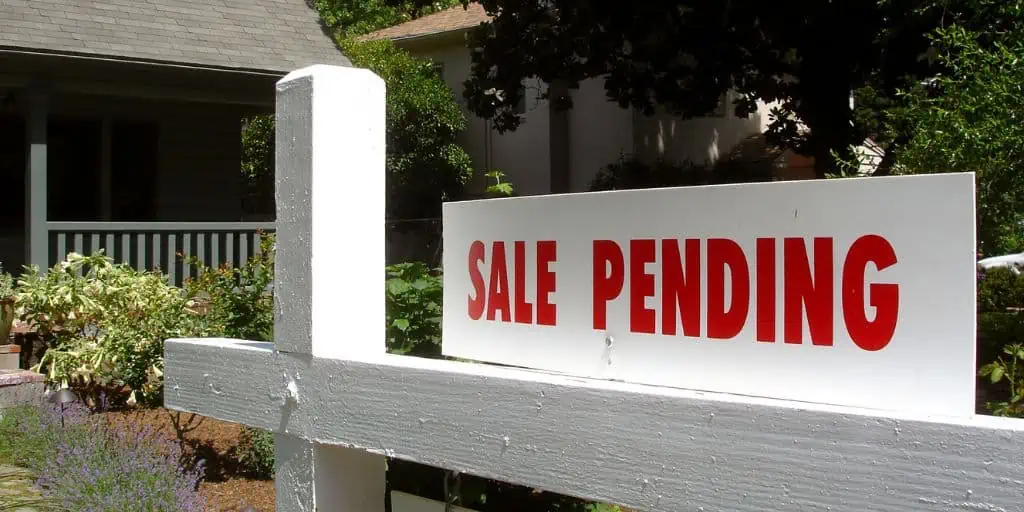What Is Pending Sale?
How Pending Sale Works
Pending sale or sale pending refers to the status of a real estate transaction where a buyer and seller have agreed on the terms of a sale, but they have not fully finalized (or closed) the transaction. This typically means that either or both parties have not yet completely satisfied the contract and any contingencies outlined in the agreement, such as a final home inspection.

A property is typically listed as pending only when a buyer meets all of the contingencies[1] the seller has laid out in escrow[2].
Pending sale is a type of listing status, similar to contingent.
Pending Sale vs. Contingent
Pending sale means that the seller has accepted an offer from a buyer and is just waiting for closing; contingent is the same, except the seller is willing to entertain offers from other buyers.
When a home sale is “contingent,” it may mean any of the following:
- Continue to Show. This means the buyer has not satisfied all or certain contingencies, prompting the seller to keep the listing active with their real estate agent and entertain other bids.
- No Show. This type of contingent status indicates that the seller has decided to stop showing the property to other interested parties due to the belief that the buyer will fulfill all contingencies.
- With or Without a Kick-Out Clause. Basically, a kick-out clause refers to the deadline the buyer must meet all contingencies.
- Short Sale. In this scenario, the seller is willing to accept offers lower than what is owed on the property. It could also mean that the short sale process has begun with a sale pending, so the seller is no longer open to new offers.
- Probate. This describes a property placed on the market because of its owner’s death.
When a property transaction is “pending sale,” it may mean any of the following:
- Taking Backups. Even with a pending deal, the seller may be accepting backup offers[3] to have other options in case the first deal falls through, similar to Continue to Show.
- Short Sale. This status is the pending sale equivalent of Contingency – Short Sale.
- More Than Four Months. A listing marked as such indicates that the pending process takes longer than usual to finish. Since the multi-listing service automatically imposes this label, it is possible that the listing agent only forgot to update the status of a property for sale from pending to sold after closing.
To understand why pending sales take a long time to close, it helps to know what happens during closing in a real estate transaction.
What Happens During Closing?
Closing refers to the final step in typical real estate transactions. In this phase, the buyer assumes legal ownership of the property after the buyer and the seller sign the sales contract. When closing is done, the transaction is considered fully completed.
Before closing happens, the buyer and the seller must first agree on the terms of the sale of the property. Once they have reached an agreement on these terms, the property’s listing will be updated to “pending sale” to reflect the status of the property in the market.
Why Does Closing Take So Long?
Closing typically takes a long time—such as a month or so—to complete because it accounts for many factors. The biggest of these is the home loan approval process.
The buyer and seller can agree to close as soon as possible, but nothing will happen if the lender is not ready to approve the home loan. As long as the buyer’s financing is in limbo, the seller is stuck with a pending home sale.
Therefore, unless the buyer is willing to pay cash, it normally takes 30 to 45 days to close on a house. The duration of the closing process can vary by loan type, location, and how hot or cold the real estate market is.
In addition, some events may also add to the length of time from pending sale to closing. For example, buyer’s credit report errors[4], loan estimate changes, missing documents, and regulatory compliance are common causes of delay.
What Can Go Wrong at Closing?
Many things can go wrong at closing and make a pending sale fall through. In this case, the transaction gets terminated and the property for sale goes back on the market.
One common mishap is when either the buyer or the seller (or, in some cases, both) back out of the transaction.
When the Buyer Backs Out
Changing one’s mind and refusing a counteroffer are perfectly acceptable reasons for walking away. However, if the buyer should back out, a good time to do this is before signing the purchase agreement[5].
In theory, the buyer could get out of a legally binding real estate contract of up to two to three weeks without consequence. After that, the buyer may lose the earnest payment[6], which can be 1% to 3% of the purchase price.
Furthermore, terminating the purchase agreement does not always come with a cost. The contract may spell out conditions that permit the buyer to back out penalty-free.
When the Seller Backs Out
If it is just a verbal agreement, the seller may back out and choose not to deal with the buyer without any legal repercussions.
However, when both parties enter into a written, legally binding contract, the seller must honor the contractual contingencies. Otherwise, the buyer may sue and ask for compensation for being wronged.
To avoid any penalty, sellers who want to walk away usually take advantage of the other party’s contingencies. For example, some sellers discourage buyers by refusing to negotiate certain components of the contract. Without the seller’s cooperation, the buyer may find that the transaction is not worth the trouble and instead do business with someone else.
Moreover, the seller may also try to convince the buyer to end the purchase agreement in good faith. Some buyers will feel sympathetic to sellers in difficult situations like not being able to find another place to move into.
Other Things That Can Derail a Closing Process
Other than one party getting cold feet, a few things may also hinder a pending sale, such as:
- Structural Issues. When a home inspector finds property defects[7] the buyer complains about and the seller refuses to assume responsibility, the initial deal can fall apart and eventually lead to contract termination.
- Low Appraisals. No lender will approve a buyer’s loan request if the property’s actual value is below what the seller wants.
- Lien Problems. A property that does not have a clear title is unacceptable collateral to any home loan lender. Unless somebody resolves all existing liens against it, the seller cannot legally transfer the ownership to the buyer.
- Natural Hazards. In states where a natural hazard disclosure report[8] is needed, the lender may demand the property be covered by hazard insurance when it is located in a high-risk area. This requirement could catch the buyer by surprise and be a deal-breaker.
- Unwilling Homeowner’s Insurance Providers. Choosing a property lender deemed as not insurable may force the buyer to pay cash completely. Since most aspiring homeowners rely on credit, a pending sale could hit a dead end.
- Discrepancies Between the Good-Faith Estimate (GFE) and the HUD-1 Form. The GFE[9] is a rough draft version of the HUD-1 Settlement Statement[10]. If the latter says that the actual closing costs are much higher than originally quoted, the buyer may be compelled to request the seller for an extension, which could be grounds for purchase agreement termination.
- Home Loan Rejections. A buyer that opts for a pre-qualification instead of a pre-approval[11] is more likely to get denied and fail to meet the agreed-upon closing date.
Takeaways
- A pending sale is a listing status indicating that the property transaction is awaiting closing.
- Pending sale usually happens when the buyer and the seller have reached an agreement over the terms of the sale, but have not closed the deal yet.
- Closing is the final step of a real estate transaction, where the seller and the buyer sign the necessary documents and the buyer finally assumes legal ownership of the property.
- As a listing status, pending sale is similar to contingent sale, but the latter is where a seller is looking for offers from other buyers.
Sources
- Ference, A. (2019.) What Does ‘Contingency’ Mean in a Real Estate Listing? realtor.com®. Retrieved from https://www.realtor.com/advice/buy/what-does-contingency-mean-in-listing/
- Lucio, A. (2021.) What Is Escrow? Zillow. Retrieved from https://www.zillow.com/home-buying-guide/what-is-escrow/
- Graham, K. (2021.) Should You Make A Backup Offer On A Home? Rocket Mortgage. Retrieved from https://www.rocketmortgage.com/learn/should-you-make-a-backup-offer-on-a-home
- Fiano, L. (2019.) Common errors people find on their credit report – and how to get them fixed. Consumer Financial Protection Bureau. Retrieved from https://www.consumerfinance.gov/about-us/blog/common-errors-credit-report-and-how-get-them-fixed/
- Drucker, A. (2017.) What is a Purchase and Sale Agreement? Redfin. Retrieved from https://www.redfin.com/blog/what-is-a-purchase-and-sale-agreement/
- Chase. (n.d.) Understanding earnest money. Retrieved from https://www.chase.com/personal/mortgage/education/financing-a-home/understanding-earnest-money
- Better Homes & Gardens. (2021.) Buyer Beware: 15 Common Home Defects. Retrieved from https://www.bhg.com/home-improvement/advice/planning/buyer-beware-15-common-home-defects/
- Gomez, J. (2021.) What is a Natural Hazard Disclosure Report? UpNest. Retrieved from https://www.upnest.com/1/post/natural-hazard-disclosure-report/
- Akin, J. (2021.) What Is a Good Faith Estimate? Experian. Retrieved from https://www.experian.com/blogs/ask-experian/what-is-a-good-faith-estimate/
- Wickell, J. (2021.) The HUD-1 Settlement Statement. The Balance. Retrieved from https://www.thebalance.com/the-hud-1-settlement-statement-1797890
- Bank of America. (n.d.) Two smart homebuying moves: mortgage prequalification and preapproval. Retrieved from https://www.bankofamerica.com/mortgage/learn/mortgage-prequalification/










